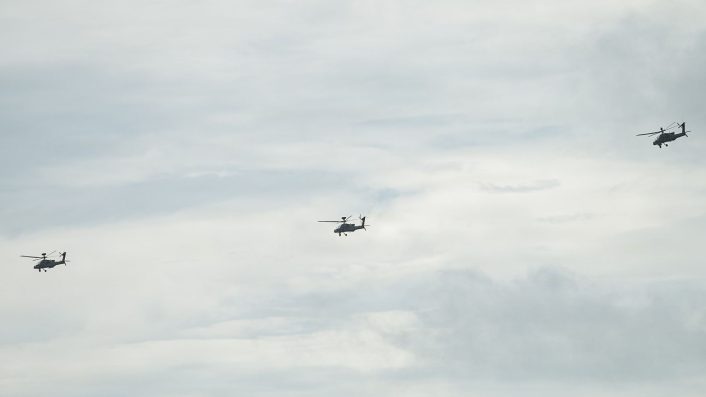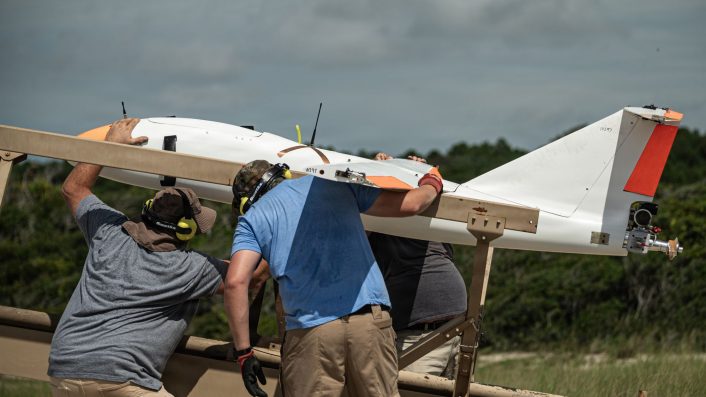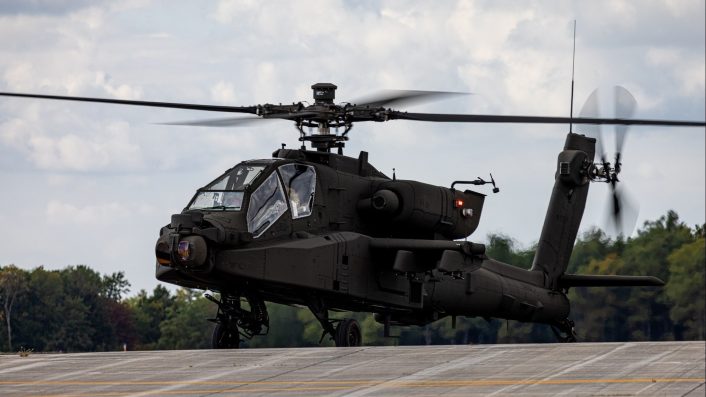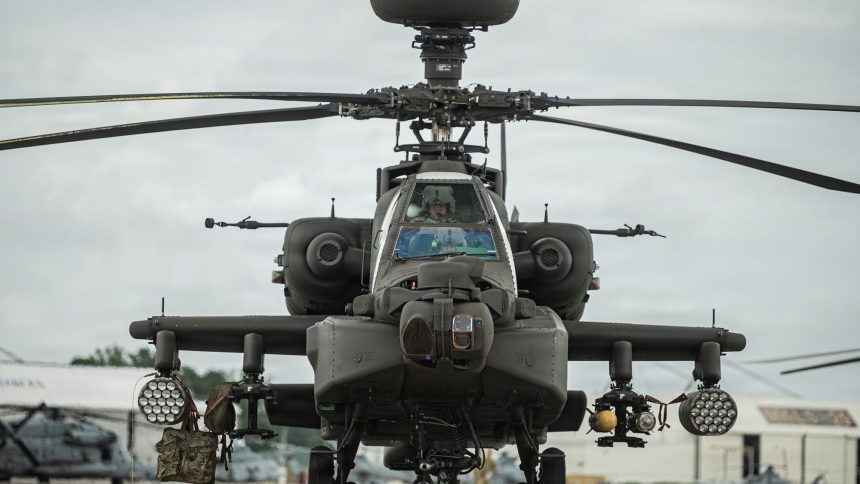Operation Flyswatter tested the AH-64E Version 6 Apache for its networked, data linked combat capabilities against a variety of asymmetric unmanned aerial threats.
The U.S. Army demonstrated the AH-64E Apache Version 6’s (V6) ability to detect, track and defeat unmanned aerial systems (UAS) during a massive live-fire event, dubbed Operation Flyswatter, at MCAS (Marine Corps Air Station) New River, North Carolina. Although this happened on Aug. 12, 2025, the service only disclosed it in a press release on Nov. 18.
Apache crews from the South Carolina Army National Guard (SCANG) employed all of the helicopter’s four primary weapons against the drones – the AGM-179 JAGM, AGM-114 Hellfire II, the APKWS II and its chin-mounted M230 chain machine gun. The Army specified different modes, tactics and the results of the combinations’ use to shoot down 13 drones out of the 14 engagements.
An image shows an AH-64E with two M261 19-round rocket pods, as well as an AGM-179 JAGM and the AGM-114R Hellfire II on an M299 launcher. The helicopter is also equipped with a Longbow radar, although the V6 Apache can also be equipped with a sensor and array-packed mast for MUM-T (Man-Unmanned Teaming) operations with drones.

In another image, three Apaches are seen flying at a distance, with the one in the rear equipped with the MUMT-X mast. A target drone, by one of the several industry partners that participated in the event, is also seen being prepared on a ground-based catapult/rail-type launcher.
Helicopters vs drones: a battlefield reality
The Apache has previously used the Hellfire during the Red Sands 24-2 exercise in Saudi Arabia in September 2024. At the time, the Army only said the Apache fired the Hellfire at a small-UAS threat, but no information was released on the practice drone employed.
U.S. Navy MH-60R Seahawk have also used the weapon in real-world conditions to bring down Houthi projectiles. Israeli Apaches have used the M230 chain guns to shoot down Hezbollah’s drones in the north.
The utility of both the Apache attack helicopter and Hellfire for counter-drone roles has been proven. The Apache had already been cleared to operate the APKWS II, similarly to the F-16 Fighting Falcon, F-15E Strike Eagle and A-10 Warthog.
Awesome Footage from earlier today, showing an AH-64 “Apache” Attack Helicopter with the Israeli Air Force, using its M230 Chain Gun to Intercept a Hezbollah Drone to the South of Haifa. pic.twitter.com/ca5vFKDBax
— OSINTdefender (@sentdefender) November 2, 2024
At an even broader level, helicopters have been used to shoot down drones with door guns. In fact, French NH90 Caiman naval helicopters and Ukrainian Mi-8 helicopters brought down Houthi and Russian Shahed-type Geran-2 attack drones, respectively.
EUNAVFOR ASPIDES 🇪🇺 | Interception par l’hélicoptère de la frégate 🇫🇷 d’un drone aérien en provenance du Yémen menaçant le trafic maritime civil en mer Rouge.
➡️ La priorité: assurer la liberté de navigation et la sûreté maritime de Suez à Ormuz https://t.co/pJjwPK2c8b pic.twitter.com/KQ8DD17hRL
— Armée française – Opérations militaires (@EtatMajorFR) March 20, 2024
🔥🔥The crew of the Ukrainian Mi-8 helicopter is chasing and shooting down the russian-iranian heavy kamikaze drone by hitting its tail section with fire from an M134 “Minigun” machine gun pic.twitter.com/410Vr3zrA9
— Angelica Shalagina🇺🇦 (@angelshalagina) November 13, 2025
Apaches vs drones at Flyswatter
The press release said: “The exercise, led by the Apache Project Management Office (PM Apache), brought together Army, National Guard, Marine Corps, Navy, and industry partners to validate the Apache’s Version 6 (V6) software and weapons package against the rapidly evolving drone threat.”
A distinguishing feature of the V6 subvariant of the AH-64E Apache Guardian is a sensor and array-packed mast for MUM-T (Man-Unmanned Teaming) operations with drones, called MUMT-X, which can replace the Longbow radar. It is unclear how this system was employed in a C-UAS scenario.
SCANG’s Apache crews’ mission profiles adopted for the detection and engagement of multiple UAS “successfully achieved 13 kills out of 14 engagements,” proving the Apache’s utility against drone threats. Chief Warrant Officer 5 (CW5) Daniel York, PM Apache New Equipment Training (NET) Team Manager said: “The Apache can engage both small and larger drones with a wide range of munitions, underscoring its operational flexibility and combat relevance.”

The Army listed the weapons, modes, tactics and their results:
- JAGM guided by Fire Control Radar: This means the AH-64E Apache Guardian controlled the JAGM with its Longbow radar after release. The JAGM has the same form factor as the Hellfire and is produced on the same production line, combining the millimeter-wave radar and laser designation in a single missile. On the Hellfire, the two seekers are available on different variants.
- Radio Frequency (RF) and Semi-Active Laser (SAL) III Hellfire missiles using both radar and laser designations: This appears to hint at two different variants of the Hellfire being used, the AGM-114L and the AGM-114, respectively.
- Hydra-70 rockets with Advanced Precision Kill Weapon System (APKWS) guidance, striking three of four UAS, with buddy-lase tactics proving especially effective: the Apaches employed the APKWS in conjunction with the buddy lasing tactic, with one helicopter acting as the shooter and the second one, the buddy, designating the target and lasing it until impact.
- 30 mm M789 high-explosive dual-purpose rounds, achieving close-range kills at under 300 meters: These rounds are the standard issue 30 mm munitions for the Apache’s M230 chain gun, which might have been fired to destroy large drones and disable them immediately.

The biggest key outcome from the exercise, according to the service, was the “13 kills in 14 engagements, demonstrating a high probability of hit/kill.” Another was validation that Link 16 data sharing and radar cueing significantly reduces sensor-to-shooter timelines.
CW5 Joel Gooch, State Standardization Pilot, said that Operation Flyswatter demonstrated the Apache’s ability to hunt drones with “radar and laser-guided missiles, laser-guided rockets, and the 30mm, while leveraging both EO/IR [Electro-Optical/Infra-Red] and radar sensors.” The Link 16 integration converts it into a “true mobile air defense platform, filling a gap that ground systems alone can’t cover,” he said.
Army’s 10th CAB receives its AH-64E V6 Apache
In a Nov. 18 release, while announcing the 10th Combat Aviation Brigade’s transition to the AH-64Ev6, the Army said the sub-variant “replaces the Brigade’s long-serving AH-64D Apaches” and offers “powerful engines, composite rotor blades and more capable integration systems.”

The Army highlighted the networked capabilities of the new Apache: “The AH 64E is a network-centric weapon system, equipped with advanced avionics that allow it to share data seamlessly across […] ground, air, space and cyber [domains], [for] both joint and ground forces,” said the service.
“The AH-64Ev6’s most revolutionary feature is its manned-unmanned teaming capability [that can] directly receive video feeds and control unmanned aerial systems of the future. This increases the Apache’s operational reach and situational awareness, allowing the aircraft to scout for threats from a standoff distance while remaining in a covered position,” the release added.









